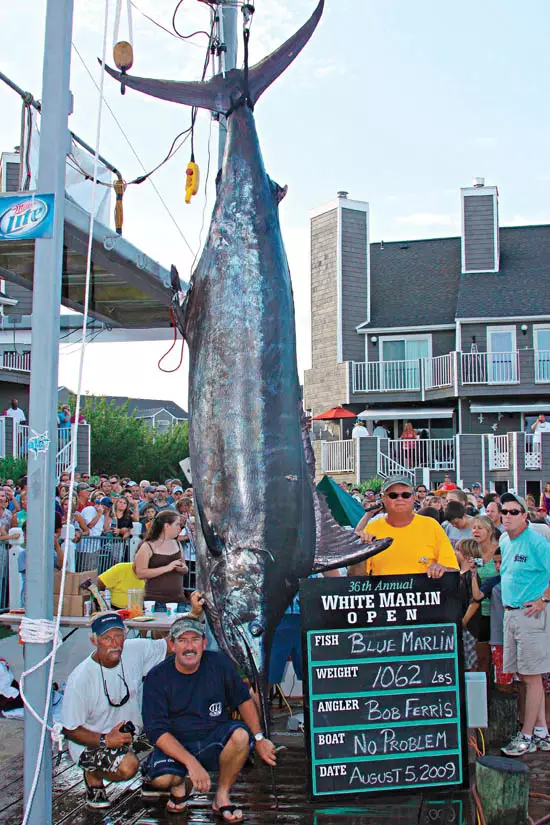Irvine says, “Once we got [the marlin] to the point to put on some [real] pressure, I got up on footrest and started heavy with my legs.” Most of the time the fish would “nose away from the boat,” he recounts. The crew could see the blue marlin underwater during the final 30 minutes of the fight but couldn’t get it to the boat. “I kept the line in water and taut knowing that the hook was no doubt loosening in the jaw,” the angler relates.
Eventually, King spun the boat sideways and gained a position next to the fish. This crew has a well-oiled end game and subdued the once-in-a-lifetime marlin without incident. But Irvine was right— the hook was loose. In fact once the fish lay on the cockpit sole, it fell out.
In August 2009, Bob Ferris was aboard the 58-foot Viking No Problem in the Baltimore Canyon with owner Mark Becker, the late Capt. Skip Opalko, and mates Tom Hurst and Scott Lawrence when his grander came knockin’.
The angler pecking order had been set. Ferris had a puppy mako release earlier, but Becker dismissed the catch and continued Ferris’ time in the chair. About 11:00 a.m., Ferris was closest to the 80 Shimano set in a bent-butt rod positioned off the short, port-side rigger. The line burst from the clip sending the trolled artificial lure for a bullet-train ride. By the time he was set in the bucket chair, the reel was down a half spool of line.
“After a blazing run, [the fish] stopped and we started gaining line,” recalls Ferris. “Then she stopped, realized [she] was hooked, and boogied, jumped, sounded, and shook [her] head for two hours. We had her to the boat ten times as another tackle buster free-jumped around us,” he adds.
No Problem also backed down about seven miles during its fight. After the two-hour tug of war, some hard pumping from the angler allowed for leader wraps. Shortly after, the fish was cleanly gaffed, her head positioned well inside the 58-footer’s saloon as the crew closed the transom door.
It would seem that the experience of these finely tuned crews blended with 21st-century fishing technology allowed for the discovery of the area’s grander country. (Some luck helped.)
“One of the locals thought fish [over 1,000 pounds] were out there, but to get them to eat and then into the boat are two different things,” Ferris says.
“It’s all about being in the area where the big guys are,” explains Irvine. “We knew the area and had intuition from past experiences.”
Gut feelings are great, but the army of antennas situated atop every battlewagon is not up there by accident. Technology can be indispensible (see “Fishing with Technology”) to locate a first-place fish. Surface-water temperatures, ocean currents, bait, and more dictate where to drop your spread—though each crew develops a personal strategy based that information.
Some teams fish the cold side of a break while others favor the warm side. Then there are crews that troll in the currents while some choose to work the edges. All teams agree that a working knowledge of the water you’re fishing gives you a leg up when pursuing a monster fish.
“We were looking at the Furuno 3-D and Sirius weather for real-time tide and temperature [information],” Irvine explains. “We wanted to stay with the tide. We could see what the tide was doing and where it was moving. Four hundred yards can make the all the difference.”
Many anglers also believe the best way to raise a big fish is with a big lure, such as your boat.
“I’ve tweaked the shafts and experimented with many sets of wheels to get what I feel looks and sounds best behind the boat when trolling,” says No Problem’s Becker. You can’t argue with his team’s success.
These crews have been able to prove that we have stateside granders right off the Eastern Seaboard, but why are we seeing them now? Is there an abundance of food? Are the numbers of big blue marlin on the upswing in these parts?
Bob Glover, tournament director of the Mid-Atlantic 500, an event that has seen some record-size white marlin in recent years, believes that conservation moves such as years of tag-and-release angling and stricter ICCAT regulations have positively impacted area billfish stocks. He also notes that recent years’ favorable weather conditions have dramatically increased angler’s time on the fishing grounds, which means more chances to find the big one.
So will 2011 be the year of the 1,300-pound blue marlin? It could be. And with the last few years’ results at the scales, spectators will be expecting it. WMO founder Jim Motsko says, “Last year we had a 700-pounder that really didn’t even get much attention at the dock.”
This article originally appeared in the April 2011 issue of Power & Motoryacht magazine.

